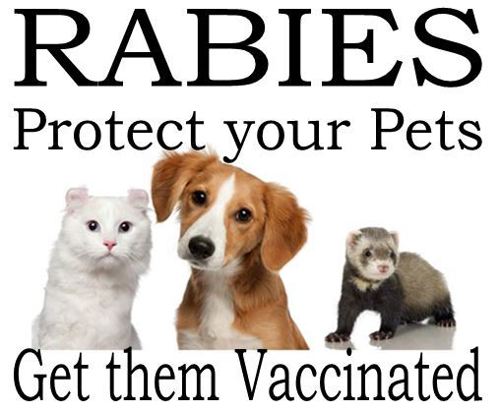Rabies 101
Posted: Jun 1, 2022

For the purpose of this article, animal refers to a domesticated cat or dog.
First and foremost, we would like to emphasize the importance of keeping your animals current on their rabies vaccine. The minimal cost of a rabies vaccination is significantly less expensive than a 10-day quarantine at Panhandle Humane Society ($200.00) or whatever price a veterinarian would charge for a 10-day quarantine. And, if you don’t have an established veterinarian, you would be less likely to find one to quarantine your animal for you. If your animal bites a person or another animal and is current on their rabies vaccine, then they can be quarantined in your home. Typically, an animal’s first rabies vaccine is good for 1 year. After the initial rabies vaccine, they are typically good for 2 years by Nebraska law, even if the rabies is a 3-year vaccine.
Now, on to some basic rabies information. The reason that an animal must be quarantined if they are not current on their rabies vaccination is to observe them for signs and symptoms of rabies. Rabies is spread through the saliva of infected animals through a bite, scratch, or contact with mucous membranes or a break in the skin. Dogs and cats can shed the virus in their saliva up to 10 days before onset of clinical signs and throughout the course of the disease. Wild animals, such as skunks, bats, and foxes, may have virus present in their saliva for longer periods before onset of clinical symptoms.
So why exactly the 10-day quarantine period? A host can carry the rabies virus but not be contagious. Once the virus enters the central nervous system, the host will start showing clinical signs and be able to transmit the rabies virus to another organism. Once the host is showing clinical signs it is usually dead within 72 hours. This is why the 10-day quarantine starts over if another bite occurs. If the host survives the 10-day quarantine it does not necessarily mean it does not have rabies, it means that it was not shedding the virus at the time of the bite. This is also why, on a rabies quarantine hold, there should be no contact, and no chance of contact with the exposing animal.
Management of the exposing animal:
A healthy, domestic dog or cat that is owned or wanted should be confined and observed for 10 days regardless of vaccination status. The 10-day period begins on day 0, which is the date exposure occurred and is completed at the end of day 10. The animal must be kept in an approved location in a manner that does not allow the offending animal to be lost to follow-up during the confinement period. Contact should be limited to prevent any other bites, as the 10-day quarantine would have to start over.
Stray dogs or cats that are known to be involved in rabies transmission which has bitten a person or caused an abrasion of the skin of a person and is unowned or the ownership of which cannot be determined within 72 hours of the time of the bite or abrasion must be immediately subject to any tests to determine whether the animal is afflicted with rabies. The 72-hour period includes holidays and weekends and must not be extended for any reason. For high-risk situations due to the severity and/or location of the bite, the holding period may be waived in lieu of testing urgency.
Testing
Can an animal be tested for rabies? The answer is yes. Unfortunately, only dead animals can be tested for rabies. A fresh brain is required for testing. The animal must be prepared for testing by a licensed veterinarian and should not be placed into a freezer.
Treatment for the exposed person
The administration of rabies post-prophylaxis (PEP) treatment is a medical urgency, not a medical emergency. When documented or likely exposure has occurred, PEP should be administered regardless of the length of delay, provided that clinical signs of rabies are not present in the exposed person. PEP is normally administered when the exposing animal cannot be found or observed for 10 days after the bite has occurred.
Wound treatment: Immediate and thorough cleansing with soap and water. If available, a virucidal agent such as povidone-iodine solution should be used to irrigate. Consider a tetanus vaccine booster. Antibiotic prophylaxis and primary wound closure depend on exposing animal, the wound size and location, and time interval since the bite.
What happens with your animal while they are quarantined at PHS?
They are given food and fresh water daily. Dogs are kept in a kennel that has two sides – a side to eat, drink, and sleep and a side to go potty. There is a door that slides between the two sides so that animal associates can safely give them food and water and clean each side. Cats are kept in a wild box or feral den. This has a circular hole in the side that is open while they are in their kennel and closed when their kennel needs to be cleaned. Dogs and cats also get treats, toys, and lots of non-contact positive engagement from the staff. There are signs on their kennels that indicate they are on a rabies hold. This is to remind staff and volunteers that the dogs cannot be walked and that cats should not be allowed to escape.
Fun fact: Opossums cannot carry the rabies virus! They also eat ticks.
*Most of this information is from the Nebraska Rabies Investigation Guideline, released January 2018.
